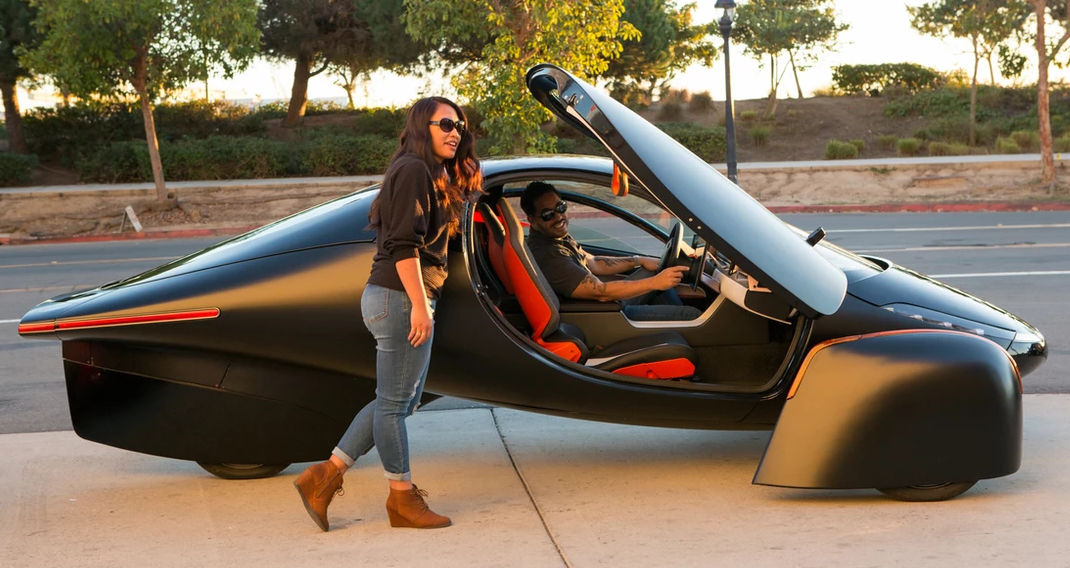If humanity wants to survive climate change, we have to find a way to create negative CO2 emissions — that is, emissions must not just go to zero, but we have to actually remove CO2 from the air. If we want to continue to have automobiles, those automobiles will somehow have to change to produce nearly zero carbon emissions. The situation reminds me of a bit by Louis CK; he’s trash, but the story in this routine is a golden example of what it’s like to coexist with narcissistic people:
There are ways that we can keep using automobiles — the problem is that they only meet 99% of America’s criteria.
Take, for example, the Aptera. It’s a car design from a US company, and they just started taking order reservations. You can order it with up to 1000 miles of range and it is so gosh darn efficient that if you get the $900 solar package, you might never need to even charge it (depending on where you live). That’s right — it literally gets more energy from the sun than most people will use driving it on a daily basis. And it isn’t even very expensive — for a cutting-edge car.
But wait. It looks like this:
I’m sure you have questions.
Does it only seat 2 people? Well, yes, most Americans rarely have more than 2 people in their automobile. Maybe some other car could take care of the rare occasion when you all need to go together.
What are the top speed and acceleration like? 100 MPH max speed, 0-60 in 3.5 seconds
Only 3 wheels? Yes, that was the efficient way to do it. It isn’t legally a car, just like a short barreled gun with a “pistol brace” isn’t legally a rifle. If you think of it as a loophole that gets you out of obeying the law, does that make it more sexy?
Does it have air conditioning? Yes
What if I need to bring along a pet elephant? Sorry, your pet elephant won’t fit, but your dog will fit in the back., as will your groceries.
Where do they hide the motor? The motors are in the wheels. They’re manufactured by a Slovenian company named Elaphe, who also makes the motors for Lordstown Motors.
It looks weird! Yes — yes it does.
It’s so weird!!! You already mentioned that.
In short, this car meets 99% of the criteria that Americans have for a car — and allows us to both keep having automobiles and not kill off humanity with climate change. But it sure isn’t our favorite way. Americans would rather kill the planet than drive a car that looks weird.
You might point to Tesla as a company that is making great strides in creating eco-friendly vehicles; however, Tesla’s cars are not efficient enough to reach zero post-manufacture emissions. They weigh too much, and are not aerodynamic enough (the Tesla model 3 has a drag coefficient of 0.23, vs. 0.13 for the Aptera). For the sake of aesthetics, no Tesla is available with any solar option at all. Although Tesla’s vehicles produce less CO2 per mile than the average gasoline automobile, they’re primarily just moving CO2 production from the tailpipe to the electric plant — very few Tesla owners can also afford enough solar power on their house to cover the entire power requirement of the car.
(Please remember that even if we all switched to vehicles that produce zero post-production CO2, the manufacturing process still produces CO2, and we still have to come up with a way to remove CO2 from the atmosphere at an enormous scale.)
In the final analysis, Tesla is a method for capitalism to create an empty display of eco-friendliness to appeal to the market and grow the economy. Much like plastic recycling, it’s a scam targeting your self-image and won’t have a significant effect on the environment. Just as gasoline-powered vehicles push the US to invade and control oil-producing nations, the battery-powered vehicle market has already contributed to the US attempt to overthrow the government of Bolivia.
(Some commentators are pretending that because Tesla didn’t order the coup, that there isn’t a relationship; the point was that the US would like to be able to control the lithium market, and they can do that by having a major producer as a puppet, even if that producer isn’t a major exporter to US manufacturers, specifically.)
The number one selling vehicle in the USA is a pickup truck. So is the second-best-selling vehicle. And the third. When I drive into work in the morning, I see those pickup trucks heading into town with one person in them each, and certainly no significant cargo. As is the case with other types of vehicles, they’re primarily being used as a commuter vehicle for one person. Typically, they’ve got 4 full doors and a stubby little bed that won’t carry most building materials. The primary purpose of the pickup truck has become to present the driver as strong and dominant. Many pickup owners don’t consider a pickup to be a “real pickup” unless it weighs over 4000 lbs — a Ranger or Canyon don’t count.
The size of American pickup trucks has increased dramatically over the years as car companies engage in a competition to make the truck that most satisfies the American truck buyer’s need to appear dominant. You can’t even buy a truly small pickup anymore. Because the primary purpose of the American pickup truck is to represent dominance, manufacturers have determined that it doesn’t make financial sense to build a pickup that is fuel efficient (an F-150 only gets about 20 MPG). Fuel efficiency is considered to be a sign of weakness. Instead, they’ve built things like the PowerBoost engine that uses an electric motor to increase acceleration and horsepower. It does use less gasoline, but the marketing materials don’t mention that.
Americans might be able to buy an electric pickup soon, but I’m confident the majority of pickups will still be belching out CO2 when our civilization collapses due to the effects of climate change. Just like the conservatives who have used their dying breath to continue to claim that COVID-19 isn’t real, America will die refusing to believe that climate change is a significant problem. Don’t forget: Automobiles have no future if we’re all dead.

